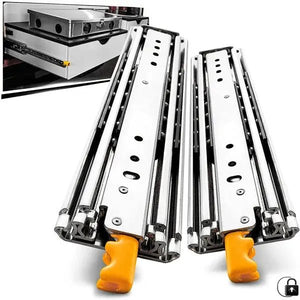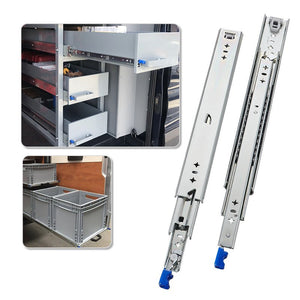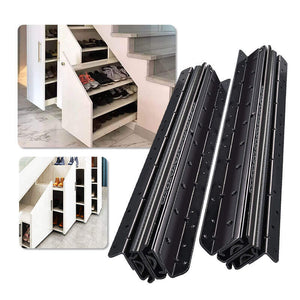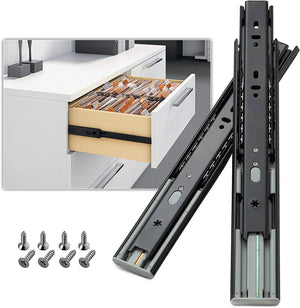I. Introduction
Soft close drawers have revolutionized the way we interact with furniture, providing a seamless and noise-free experience. In this guide, we delve into the intricacies of these innovative drawers, understanding their mechanisms, benefits, and addressing common issues users might encounter.
Soft close drawers, also known as slow close or self-close drawers, have become a hallmark of modern furniture design. As we navigate through the features and maintenance tips, you'll discover how these drawers not only add a touch of sophistication to your living spaces but also contribute to the longevity of your furniture.

II. Diagnosing the Issue
Soft-close drawers, while providing a great experience, may occasionally encounter issues. Understanding and diagnosing the problem is critical to restoring their optimal functionality.
Observing the Drawer's Movement
Soft-closing drawer design, smooth and silent operation. If the following problems occur, we need to pay attention to any irregularities in the movement of the slide rails. For example: sudden or uneven movement when the drawer is pulled out may indicate that the rails are misaligned or there are obstacles. We can diagnose by opening and closing the drawer.
Listening for Unusual Sounds
In addition, sound cues can often reveal problems with drawer slides.Listen for any unusual sounds during the drawer's operation. Squeaks, creaks, or grinding noises may indicate friction, worn-out components, or the need for lubrication.
Inspecting for Visual Damages
One of the most direct ways to do this is to pull out the drawer and look at the slide rails to look for damage, such as bent rails, broken rollers, or any loose screws. Visually identifying these issues can guide you to effectively solve a specific problem.
Tools You Might Need for the Diagnosis
Gathering the right tools for the diagnosis ensures a thorough examination:
-
Screwdriver: Essential for inspecting and tightening any loose screws.
-
Soft Cloth: Useful for cleaning and wiping down components during the inspection.
-
Lubricating Spray: If needed, this aids in addressing friction-related issues.
By incorporating these steps and tools into your diagnosis, you'll gain valuable insights into the potential issues affecting your soft close drawer's performance.

III. Step-by-Step Guide: Putting a Soft Close Drawer Back on Track
When a soft close drawer veers off course, restoring it to its seamless glory requires a systematic approach. This step-by-step guide ensures a hassle-free process for getting your soft close drawer back on track.
Addressing Misalignment Issues
Soft close drawers can misalign due to various reasons, impacting their smooth operation. Follow these steps to address misalignment issues:
-
Locate the Roller Adjustment Screws:
- Identify the screws responsible for adjusting the rollers on either side of the drawer.
-
Using a Screwdriver to Make Adjustments:
- Carefully use a screwdriver to turn the adjustment screws. Clockwise adjustments typically raise the drawer, while counterclockwise adjustments lower it.
-
Testing the Drawer's Movement:
- Open and close the drawer multiple times to assess its movement. Adjust the screws as needed until the drawer operates smoothly.

Checking and Clearing Track Obstructions
Track obstructions can hinder the soft close mechanism. Here's how to address this issue:
-
Identifying Obstacles in the Track:
- Inspect the drawer track for any debris, foreign objects, or accumulated dirt that might impede the drawer's movement.
-
Using a Soft Cloth to Clean the Track:
- Gently wipe down the track with a soft cloth to remove any obstructions. Ensure the track is clean and free from impediments.
-
Ensuring Smooth Movement:
- Test the drawer's movement after cleaning the track. The soft close mechanism should operate seamlessly without any disruptions.
Examining Damaged or Worn-out Rollers
If misalignment persists, the issue might be with damaged or worn-out rollers. Follow these steps to address roller-related problems:
-
Inspecting Rollers for Wear and Tear:
- Examine the rollers for signs of wear, damage, or deformation. Worn-out rollers may need replacement.
-
Replacing Damaged Rollers:
- If any rollers are damaged or excessively worn, replace them with compatible replacements. Follow manufacturer guidelines for replacement parts.
-
Testing the Soft Close Mechanism:
- After replacing rollers, test the soft close mechanism by opening and closing the drawer. The drawer should now operate smoothly.
By systematically addressing misalignment, track obstructions, and roller issues, you can bring your soft close drawer back on track, ensuring a quiet and seamless experience.

IV. Preventive Measures for Soft Close Drawers
Ensuring the sustained performance of soft close drawers involves not just fixing issues but also adopting preventive measures. Explore these proactive steps to keep your drawers operating smoothly for the long term.
Regular Cleaning and Maintenance
-
Dust and Debris Management:
- Regularly clean the drawer tracks to prevent the accumulation of dust and debris. Use a soft brush or cloth to remove any particles that may hinder the smooth movement of the drawer.
-
Lubrication Routine:
- Apply a silicone-based lubricant to the drawer tracks and soft close mechanism. This routine lubrication reduces friction, promoting seamless operation. Ensure to follow the manufacturer's recommendations for the type of lubricant to use.
Weight Distribution Awareness
-
Adhering to Weight Limits:
- Soft close drawers come with specified weight limits. Avoid exceeding these limits to prevent strain on the mechanism. Distribute weight evenly across the drawer to ensure balanced operation.
-
Periodic Weight Checks:
- Periodically assess the contents of the drawers to ensure they align with the recommended weight limits. Removing excess weight can contribute to the longevity of the soft close mechanism.
Temperature and Humidity Considerations
-
Avoid Extreme Conditions:
- Soft close mechanisms may be sensitive to extreme temperatures and humidity. Avoid placing drawers in areas exposed to direct sunlight, extreme cold, or high humidity, as these conditions can affect the performance of the mechanism.
-
Climate-Controlled Spaces:
- Consider installing soft close drawers in climate-controlled areas to mitigate the impact of temperature and humidity fluctuations.
Periodic Hardware Checks
-
Screw Tightening Routine:
- Establish a routine for checking and tightening screws, especially those securing the soft close mechanism. Loose screws can contribute to misalignment and impact performance.
-
Drawer Alignment Verification:
- Periodically verify the alignment of the drawer within its tracks. Adjust as needed to maintain proper alignment and prevent operational issues.
Adopting these preventive measures not only enhances the longevity of soft close drawers but also reduces the likelihood of encountering operational disruptions. By integrating these practices into your regular maintenance routine, you contribute to a hassle-free and prolonged drawer experience.
V. Frequently Asked Questions (FAQs)
Q1: How Does a Soft Close Drawer Work?
A: The soft close mechanism employs specialized hinges or slides with built-in dampers. These dampers control the closing speed of the drawer, ensuring it glides gently and comes to a silent, soft close. It adds an element of controlled deceleration, preventing slamming and reducing wear and tear over time.
Q2: Can I Retrofit Soft Close to Existing Drawers?
A: Yes, it's possible to retrofit soft close mechanisms to existing drawers. Retrofit kits are available, including dampers and slides, allowing users to upgrade their drawers to incorporate the convenience of soft close functionality. Follow the provided instructions for a seamless installation process.
Q3: Are Soft Close Drawers Durable?
A: Soft close drawers are designed with durability in mind. The mechanisms undergo rigorous testing to ensure they can withstand repeated use without compromising performance. Choosing high-quality materials and proper installation contribute to the longevity of soft close drawers.
Q4: Do Soft Close Drawers Require Special Maintenance?
A: While soft close drawers are low-maintenance, regular cleaning and occasional lubrication of the slides can enhance their performance. It's advisable to follow the manufacturer's maintenance recommendations to keep the mechanism in optimal condition.
Q5: Can Soft Close Drawers Accommodate Heavy Items?
A: Yes, soft close drawers come in various weight capacities. It's essential to adhere to the specified weight limits to ensure smooth operation. Heavy-duty soft close mechanisms are available for drawers intended to carry heavier loads. Always check and follow the manufacturer's weight guidelines.
Q6: What Should I Do If My Soft Close Drawer Is Misaligned?
A: Misalignment can occur due to various factors. Begin by checking for any obstructions in the tracks and ensuring the drawer contents are within the recommended weight limits. If the issue persists, refer to the user manual for guidance on adjusting the alignment or contact the manufacturer's customer support for assistance.
These frequently asked questions shed light on the functionality, maintenance, and adaptability of soft close drawers. By addressing these queries, users can make informed decisions and enjoy the benefits of this modern drawer technology.
VI. Conclusion: Enhancing Your Drawer Experience
As we conclude our exploration into the world of soft close drawers, it becomes evident that these innovative mechanisms are more than just a convenience—they represent the future of drawer functionality. The blend of advanced engineering, user-centric design, and durability positions soft close drawers as a staple in modern furniture solutions.
In conclusion, soft close drawers are more than a technological advancement—they are a testament to the continuous pursuit of improving our daily lives. As we embrace the future of drawer technology, let's appreciate the subtle luxury and practicality that soft close drawers bring to our homes, making everyday interactions smoother and more enjoyable.







